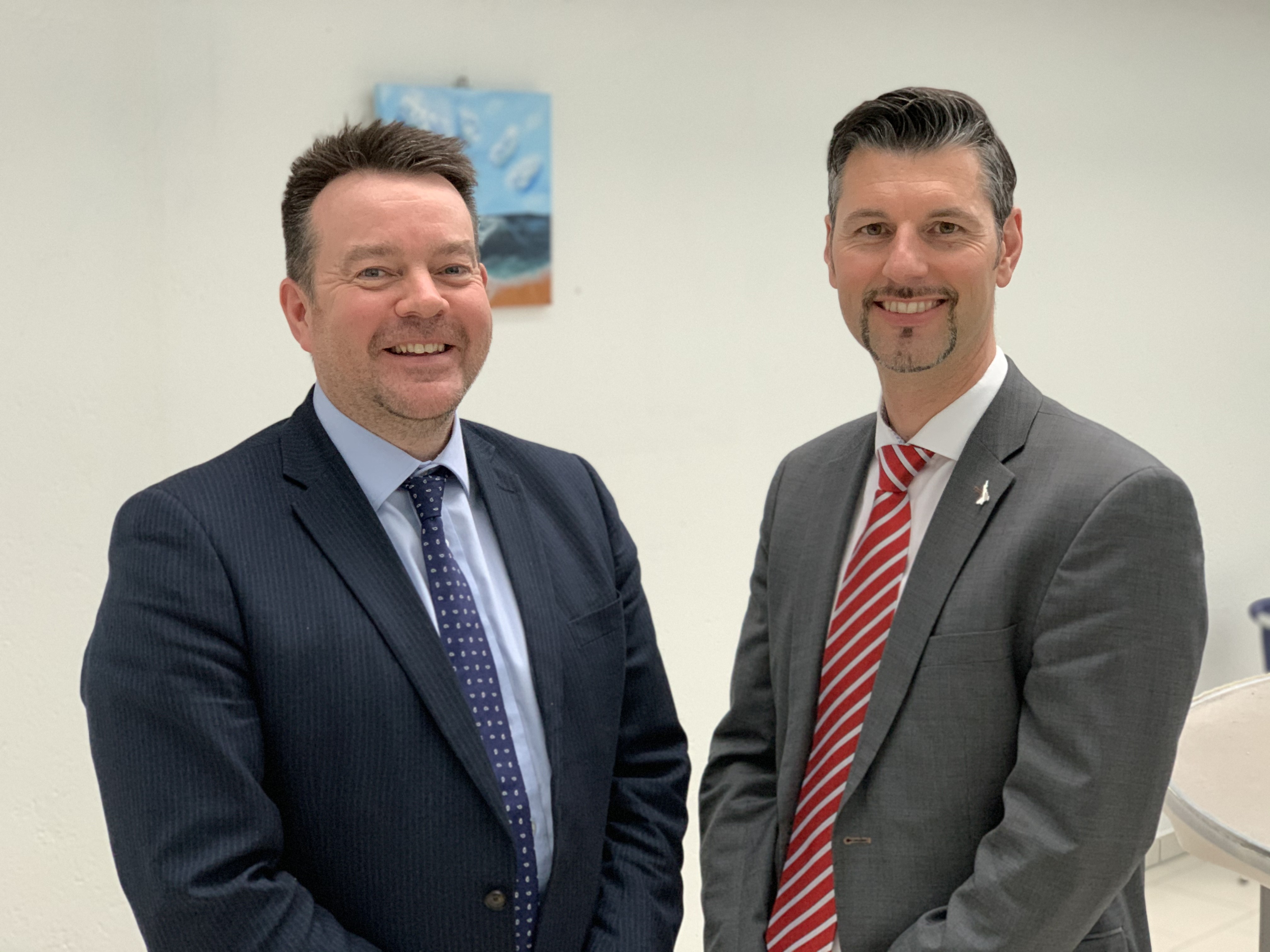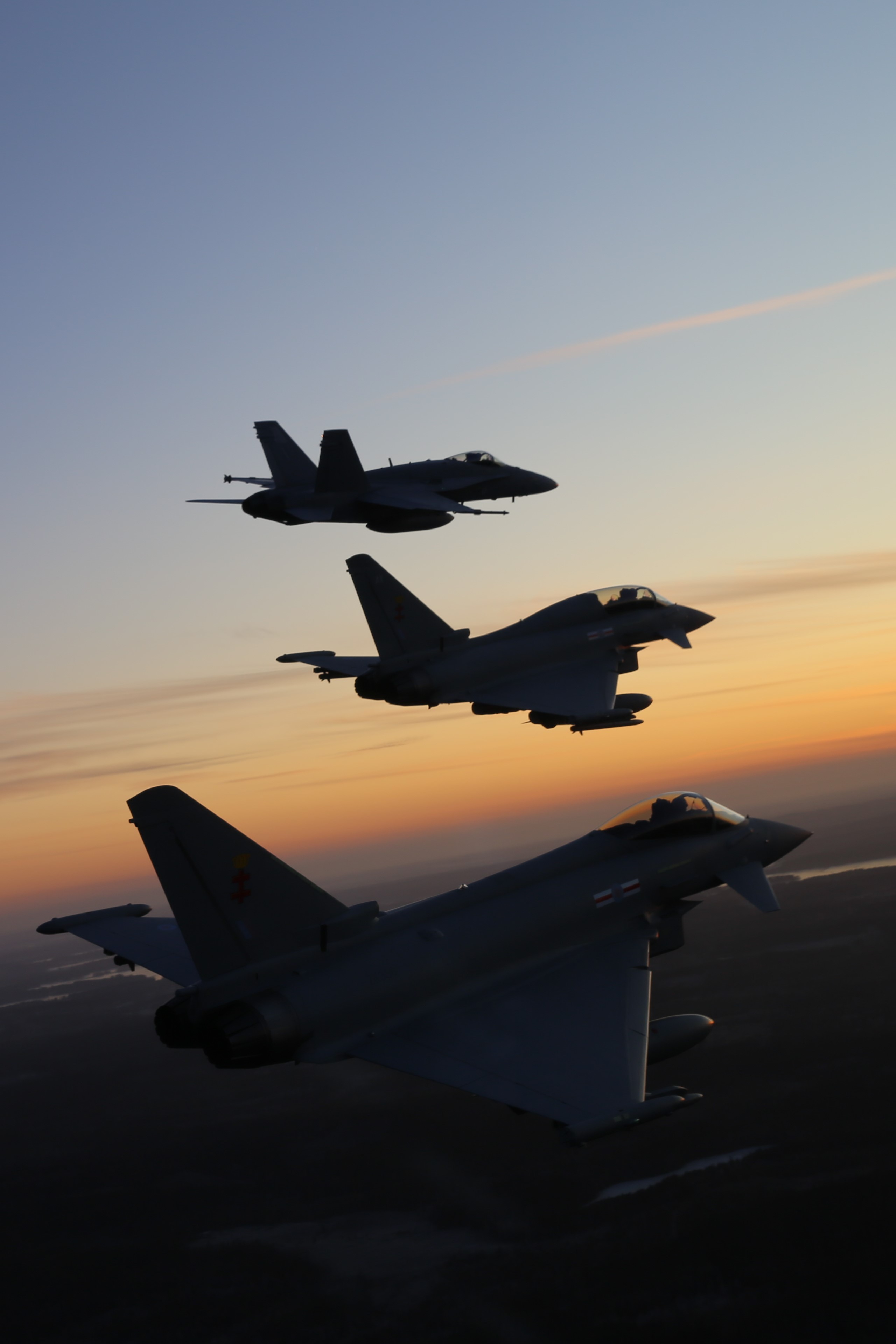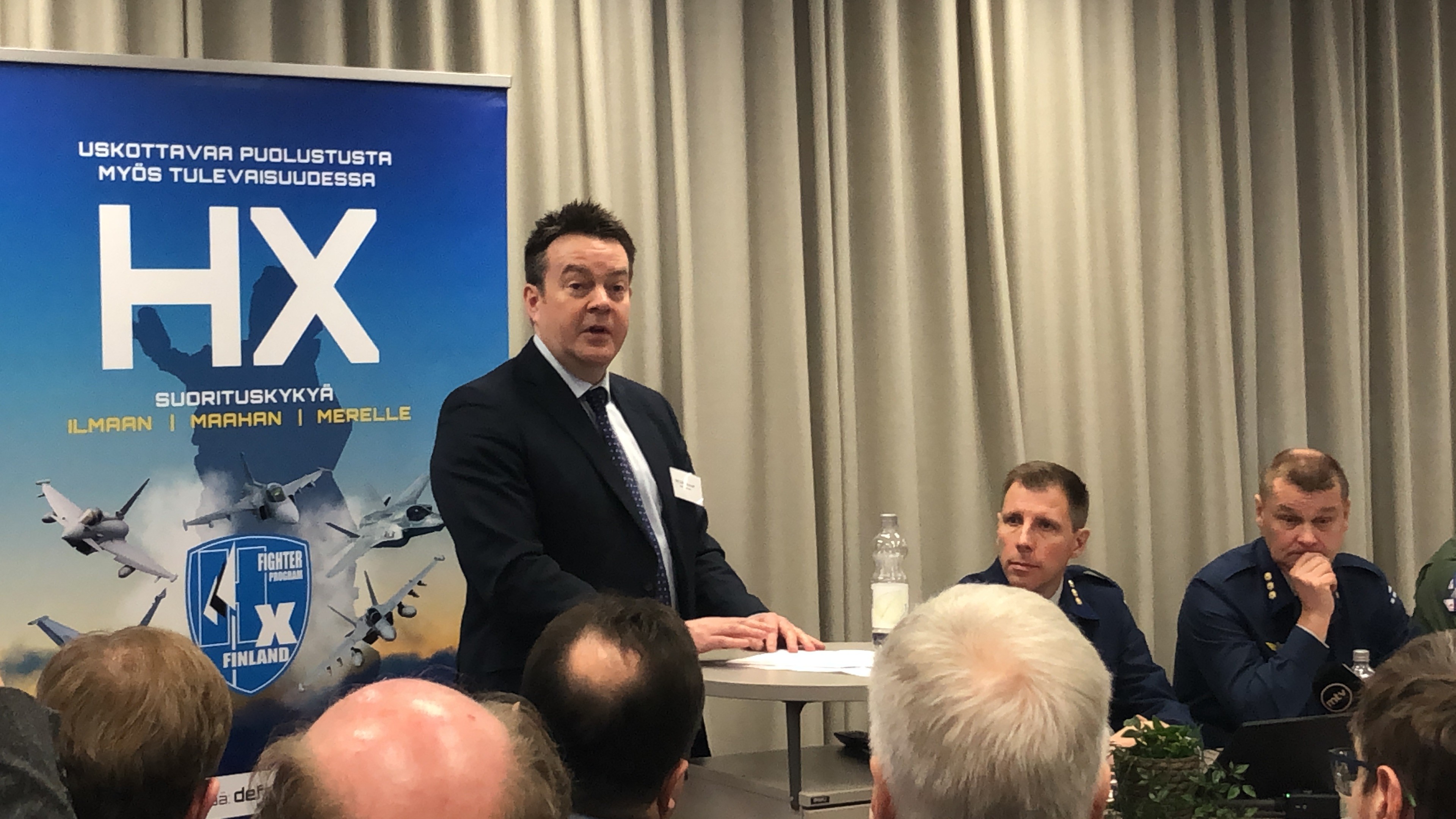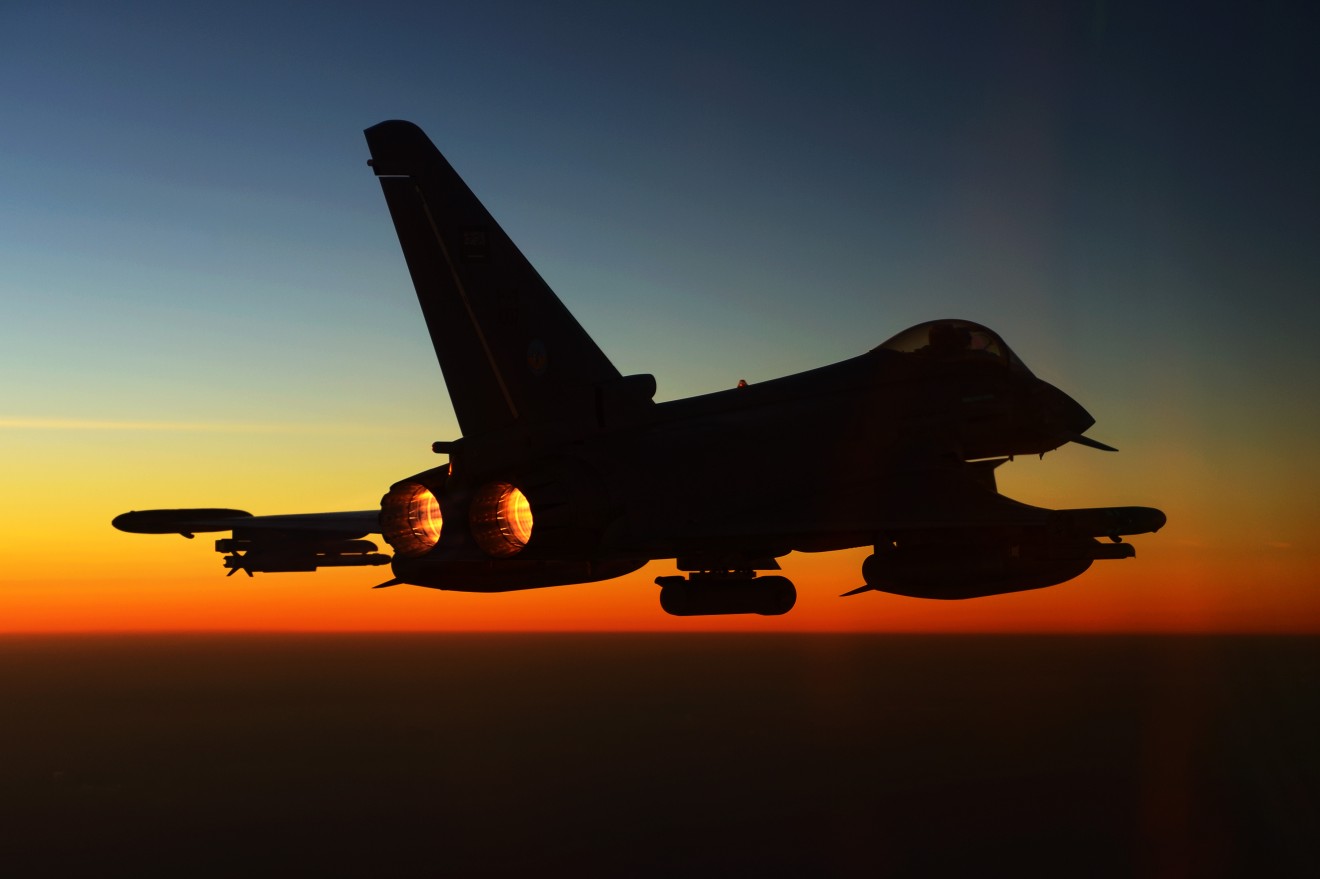
John Rossall (left), HX Campaign Director, BAE Systems and Franz Posch (right), CEO, DS Schweiz Airbus, understand each other’s roles well. The two men respectively lead the Swiss and Finnish campaigns on behalf of the Eurofighter partners.
SOVEREIGNTY AND MISSION DATA
“Sovereignty is key to our offers in Finland and Switzerland,” says John. “It’s an important and complex issue but one way to help understand it is thinking about it in terms of a social media site. A couple of years ago, people didn't understand that Facebook or Instagram could hold and use all their personal data unless they ticked a box. Nor did they realise that these companies could pass this data on to marketing companies or whomever. Today society is much more aware and eager to protect personal data.”
“If you think about how important your personal data is, then consider it in terms of a nation’s military and security data then you can see how imperative the protection and sovereign control of information is.”
The collaborative nature of the Eurofighter programme and the core nations ensure that new partners are equipped to collect and exploit their sovereign data. The ability to do this is unique to European offers. The speed, and programmability and therefore usefulness is unique to Eurofighter.
What we are talking about is being able to assess the data you're collecting and use it to defeat threats. Eurofighter will allow you access to your data and to your sensors so you can adapt them to the threat. Essentially, it allows you to do things you need to do to gain a military advantage. If you don't have sovereign control of your data, then you've got to seriously question your ability to sustain military credibility now and in the future.
“What we clearly demonstrated in Finland was that Eurofighter was able to identify potential threats and that, afterwards, the planner was able to reprogram the mission data, providing it back to the aircraft. This is how it knows how to deal with threats. The unique thing about Eurofighter, is that it can be turned around on a sortie by sortie.”
John says this message around sovereignty and mission data is starting to land. “Let’s face it, we’re talking about titanium, carbon fiber, and two phenomenal engines. But the crucial element is all the 1s and 0s.
It's sensors, it's data and your ability to access the 1s and 0s and analyse them and use them. That’s really what you’re buying. All the hardware does is collect that data — if you don't control that, if you can’t defend yourself against the threat and you can’t direct your complex weapons to a target, then all you’re left with is a very expensive bit of kit that you might not even be able to fly.”
SECURITY OF SUPPLY
Both nations put a strong emphasis on security of supply and software. They both respect the fact that they have to have sovereign capability and need to be able to act independently. Hence the importance of the sovereignty issue.
ENDURING CAPABILITY

Both nations want confidence that their chosen platform will be flying and supported into the 2060s. Eurofighter is a phenomenal platform, with a fantastic structure and very powerful engines. And it's got potential for growth in those two areas. The military capability is changing its sensors, its weapons. 2060 is important but both nations want to understand the Eurofighter capability road map that will ensure its relevance throughout its years in service.
STRONG EUROPEAN FOOTPRINT
This notion is becoming more and more important. From a Finnish perspective, Finland is a very pro Europe nation. Part of being a European solution means collaboration is in our core.
It’s a similar story in Switzerland. Says Franz: “We are proud to point to Eurofighter as the European solution because we offer common training, common exercises with the partner nations, while also allowing the Swiss to retain the ability to operate their fleet independently.”
“Sometimes Eurofighter is misunderstood and viewed simply as a product. The truth is that it's really Europe's biggest multinational defence programme. We have four core nations and three of the biggest defence companies in Europe behind it. If you want to compete in F1 you don't buy simply an F1 car, you need to be part of a team.”
SWITZERLAND
WHAT IT WANTS
Switzerland needs to replace its ageing fleet of F-5s and F-18s, which are planned to be phased out between 2025 and 2030. The contest started with a Request for Proposal in 2018, which was focused on the capabilities they were looking for from a replacement.
Switzerland is a neutral state, not a member of NATO, and its major task is air policing, but in ‘intense situations’ they want to be able to defend their airspace.
Switzerland is asking for 36 aircraft in full condition, with everything included in their package. They also want to have a single price for four additional aircrafts, with a budget of 6 billion Swiss francs. Switzerland is asking for an offset commitment of 60% of the purchase price.
“The good thing is Switzerland has very clear requirements, a confirmed budget, as well as a clear and well-defined evaluation process. Interestingly they are asking for a solution that is very similar to the one Germany is introducing. Consequently, This Swiss Eurofighter would be almost exactly the same.”
THE PROCESS SO FAR
Last year the competition moved into a key stage — the Flight Evaluation Phase. Explains Franz: “The flight trials are a huge effort and carry lasting significance. In effect, all the things we had claimed in the proposal had to be demonstrated in the flight evaluations. We mainly used UK Eurofighter jets, but supplemented those with a German Eurofighter because they had different software configurations. We needed both variants to really show exactly what’s available.”
HOW HAS EUROFIGHTER FARED?
“We flew all the missions and performed all the tasks they gave us. We had a two-seater aircraft and they sat in the back in order to get a direct view. They were also flying alongside us using their own F-18s to see close up what we are doing. After the flights, the pilots took part in extensive debriefings. The whole effort was carried out in a hugely professional way from both sides. There are very strict rules governing the process but the result was that the customer was really satisfied.”
The Swiss evaluations highlighted another Eurofighter strength: reliability. “We took an Airbus A400M loaded with spare parts to Switzerland for the trial, but we didn’t need a single screw, which showed them Eurofighter’s high reliability.”
In addition to the live flying, the Swiss team also carried out simulator trials in Germany and the UK, looking at a number of different weapon configurations, so they could get a feel of what's possible in different scenarios.
A KEY ISSUE
Lifecycle costs are crucial, says Franz: “A support audit took place last year. Switzerland is particularly interested in the lifecycle costs of whatever they finally end up procuring and how you operate your aircraft over time. One of the reasons for this is that Switzerland will be the last nation flying F-18 as it’s more or less at the end of its lifecycle. As such they're having to invest heavily in order to keep their F-18 fleet operating. They’ve found it's very expensive at the end of the lifecycle if you're the only user left. Hence recent pronouncements stating that Eurofighter will be flown beyond 2060 are very important for Switzerland, because they don't want to be in the same situation again.”
WHAT’S NEXT?
In January this year, the Swiss team received the RFP Part 2 which puts the focus on what it will actually deliver, and this proposal has to be delivered by August 19th — it’s the Best and Final Offer (BAFO) stage. Says Franz: “That’s it until Type Selection and this will be made in Quarter 1, 2021. However, the final details on fleet sizing, weapons and mission equipment will be taken after the Type Selection.”
The final decision will be made on the minister's level of all seven ministers because it's a strategic decision. It's not only about the product. It's about a partnership, their security relationships, and this is a very important factor in the process.
CAN WE WIN?Our strong belief is that we have a very stable solution.
FINLAND

WHAT IT WANTS
Finland too is looking for replacements for its F-18 fleet and delivery timescales are similar, being required between 2025 and 2030. Finland’s primary requirement is to defend its territory. Eurofighter is fast, it can fly high and carry an array of advanced weaponry, and that’s exactly what you need when you have a threat in your airspace.
John says: “Finland has identified a number of scenarios which they need to defeat. The configuration of Eurofighter we will propose, will include capabilities that are not currently on the aircraft today, but they are part of the UK RAF’s requirements and will be embodied prior to when deliveries are due to commence.”
THE PROCESS SO FAR
“We submitted an RFQ response in 2019 and a revised RFQ response on 31st January 2020. We are continually developing the solution that we'll finally offer the Finnish customer and this process will go up until the end of May this year (some programme changes may result from COVID-19). Then they will produce their Best and Final Offer documentation, which we will respond to,” says John.
Finland has carried out cold weather flight evaluation trials where they operated the Eurofighter at base for the week. But there are other evaluations too, including simulator trials which will be used to verify some of the things we've offered in our proposal.
KEY ISSUES
1. Support: On the support side the UK has demonstrated through TyTAN that it can provide high availability at a low operating cost, and an availability-style contract will be proposed at the sustainment phase. But we'll do that in partnership with the Finnish military and industry.
“We will transfer as much MRO (Maintenance, Repair and Overhaul) capability as we possibly can to Finland, in order to be as close to the operator as possible. That means that the operators can deliver the maximum military capability possible; provide the means to drive platform availability; making airplanes available for flying the missions. By providing support as close to the aircraft as possible, we will also need to provide airworthiness and engineering support – which we can and will do.”
2. Sovereignty: Eurofighter will provide Finland with sovereign control of their own mission data. That’s a key USP in both these competitions.
WHAT’S NEXT?
The due date for BAFO delivery is at the end of April 2021.
CAN WE WIN?Yes. Eurofighter was designed to be a phenomenal air superiority fighter. The Centurion Programme transferred air-to-surface capabilities to Eurofighter that made it a world beating multi/swing-role fighter. Investment in Eurofighter, that will introduce new complex weapons, expand the flying envelope, enhance its sensors and person-machine interfaces make Eurofighter a very strong capability for Finland. Add the military capability to the political and industrial partnership in Europe and Eurofighter wins.
